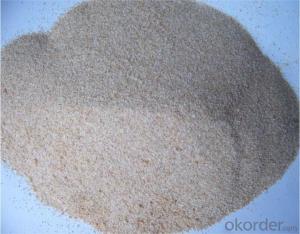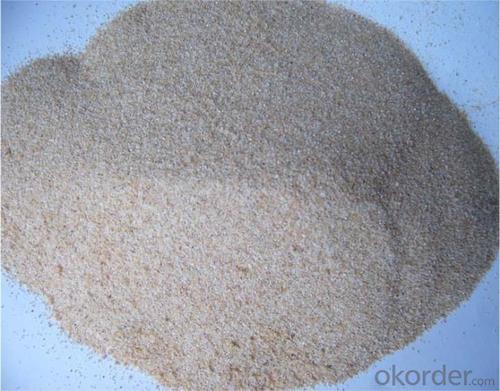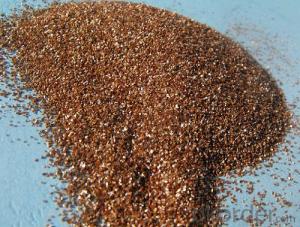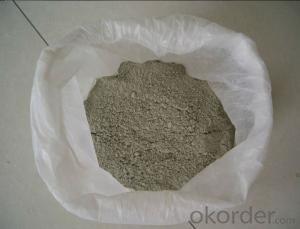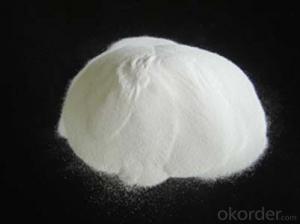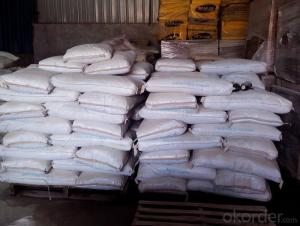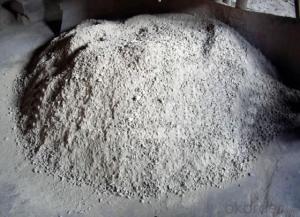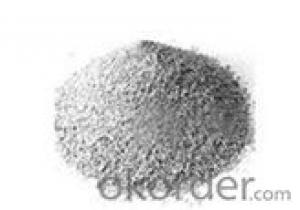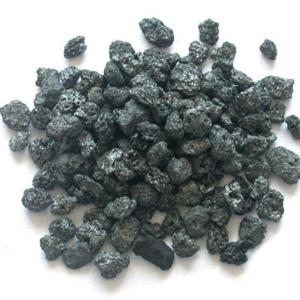Raw Materials for Refractory:High Alumina Low Cement Castable Ladle Tundish Refractory Cement
- Loading Port:
- China main port
- Payment Terms:
- TT OR LC
- Min Order Qty:
- 25 m.t.
- Supply Capability:
- 2000 m.t./month
OKorder Service Pledge
OKorder Financial Service
You Might Also Like
Definition
It is a non-metal inorganic construction material based on calcium aluminate(CaO•Al2O3) or calcium dialuminate(2CaO•Al2O3).It is made up by the way of having natural bauxite or industrial alumina and calcium carbonate(limestone) which are in certain proportion calcined or electric melted, it can also be made through melting laterite and limestone. Compared with silicate cement, calcium aluminate cement has a higher refractoriness, thus it is widely used as binder of refractory castable.
Category
Calcium aluminate cement is sorted into two kinds by chemical composition: common calcium aluminate cement (Al2O353%~72%,CaO21%~35%) and pure calcium aluminate cement(Al2O372%~82%,CaO19%~23%). And common calcium aluminate cement is divided into low iron type(Fe2O3<2.0%) and high iron type(Fe2O37%~16%). The low iron type calcium aluminate cement which has a Al2O3 content of 53%~56% and CaO of 33%~35% is called bauxite cement; the one which has a Al2O3 content of 59%~61% and CaO of 27%~31% is called Aluminium-60 cement; the one which has a Al2O3 content of 65%~70% and CaO of 21%~24% is called low calcium aluminate cement, another kind is fast hardening super early strength calcium aluminate cement. And pure calcium aluminate cement is divided into conventional type (Al2O3 content is 72%~78%)and super high alumina type(Al2O3 content is 78%~85%).
Specifications:
Specification of three grads of CA50 | ||||
Mark | A600 | A700 | A900 | |
Composition (%) | SiO2 | ≤7.8 | ≤7.5 | ≤5.5 |
Al2O3 | ≥50.0 | ≥51.0 | ≥53.5 | |
Fe2O3 | ≤2.5 | ≤2.5 | ≤2.5 | |
Fe2O3 | ≤0.4 | ≤0.4 | ≤0.4 | |
SSB (m2/kg) | ≥300 | ≥320 | ≥350 | |
Initial Setting Time(min) | ≥45 | ≥60 | ≥90 | |
Final Setting Time (h) | ≤6 | ≤6 | ≤6 | |
Breaking Strength(MPa) | 1d | ≥6.0 | ≥6.5 | ≥8.0 |
3d | ≥7.0 | ≥7.5 | ≥10.0 | |
Compressive Strength(MPa) | 1d | ≥45 | ≥55 | ≥72 |
3d | ≥55 | ≥65 | ≥82 | |
Item Briand |
CA70 |
CA80 | |
Chemical Composition % | SiO2 | ≤1.0 | ≤0.5 |
AL2O3 | ≥68.0 | ≥77.0 | |
Fe2O3 | ≤0.7 | ≤0.5 | |
R2O | ≤0.4 | ≤0.4 | |
S | ≤0.1 | ≤0.1 | |
Cl | ≤0.1 | ≤0.1 | |
325M Residue on Sieve (%) | ≤5 | ≤5 | |
Surface Area (m2/kg) | ≥400 | ≥450 | |
Initial Setting Time (min) | ≥45 | ≥45 | |
Final Setting Time (h) | ≤6 | ≤6 | |
Breaking Strength (MPa) | 6h | -- | -- |
1d | ≥5.5 | ≥5.0 | |
3d | ≥6.5 | ≥6.0 | |
Compressive Strength (MPa) | 6h | -- | -- |
1d | ≥40 | ≥30 | |
3d | ≥50 | ≥40 | |
Application
Calcium aluminate cement is mainly used as binder of refractory castable and gunning mix. Common calcium aluminate cement is applicable to low-grage and medium-grade refractory castable, such as firecaly castable and high alumina castable etc; Pure calcium aluminate cement is applicable to high-grade refractory castable, such as corundom castable, mullite castable, chrome containing corundum castable and spinel castable etc; The calcium aluminate cement addition quantity of common refractory castable is 10%~20%, low cement castable is 5%~10%, super low cement castable is less than 5%. Addictives which can improve workability may be added to castables bond by calcium aluminate cement so as to meet the requirements of construction, such as setting accelerator, setting retarder, water reducer (dispersant), plasticizer etc.

- Q: Can anyone tell me what is A-leve fireproof material?
- Combustion performance of materials can be divided into: A-level, B1-level, B2-level and B3-level, which respectively refer to noncombustible, difficult-flammble, flammable and inflammable materials. Building materials can be divided into four grades based on combustion performance (noninflammability, flame retardancy, flammability and inflammability). According to the stipulation of "Specification of Fireproof Design for Buildings" (GBJ16-1987) (2001 revised edition), fire hazard of production or storage should be divided into A-level, B-level, C-level, D-level and E-level. In "Specifications on Fireproof Design for Petrochemical Enterprises" (GB50160--1992) (1999 Revision), it also stipulates that fire hazard should be classified on the same basis of subtsance danger in usage, production or storage. According to different fire hazard, requirements and measures of oreventing and restricting fire explosion can be put forward from the aspects of fire?separation distance, fire resistant rating of buildings, allowed floors, safe evacuation, fire fighting facilities and other aspects.
- Q: Refractory net
- Foreign enterprises created not only for profit, but a career, hope to be able to last forever; domestic, especially private enterprises, most of them do not have such a vision, only to a loophole, cash, so never to do this industry.Welcome to discuss the statements of a school.
- Q: As for fireproofing material rock wool and glass wool, which one is better?
- Rock wool board and glass?wool?board are a kind of new construction thermal insulation material, it's widely applied in construction and has replaced traditional thermal insulation material to some degree. With the gradually deepening study of rock wool board, glass wool board, we can find that these insulation materials have advantages in many aspects but there are also many deficiencies, particularly there exists a lot of controversy about the impact on the human body. The production process of rock wool board and glass?wool?board usually includes: after melting in high temperature of rock or glass, inorganic fiber is produced by high-speed centrifugation equipment, and at the same time add binder,dust?laying?oil,silicone oil at certain proportion, then produce sheet material according to different requirements. It has good thermal insulation properties, mechanical?property, sound absorption characteristics, belong to incombustible?material and is cheap. In general, insulation, security and economy should not be contradictory, three aspects should be taken into account, balanced chosen and developed. Rock wool board and glass wool board and other such materials should be properly selected and applied to the appropriate structure, so that the choice of material will play their strengths and avoid their weaknesses.
- Q: what's the classification of fireproof and thermal inuslation matertial?
- Inorganic thermal insulation material can do it, such as glass wool,rock wool,foam glass,etc. phenolic foam materials in organic foam material is special. phenolic foam not only has good thermal insulation properties but also can be composited with steel plate and other materials, A class thermal insulation materials that reach A class combustion performance include: rock (mine) wool, foam glass, EVB, etc. thermal insulation materials with A class combustion performance mainly include: phenolic aldehyde,gelatine powder polyphenyl granule, etc. thermal insulation material of fire barrier zone can use rock (mine) wool, foam glass, EVB and other materials with A class combustion performance.
- Q: who knows the uses of refratories?
- 1. Category: chinalco refractory aggregate Al2O3 containing about 35% -40%, high-alumina refractory aggregate containing 55% Al2O3. Widely used in thermal equipment, high-temperature furnace wall, heatable brick bed, chimneys, lining and other basic construction, it is mainly used in military, warehouse, air defense, industrial and mining enterprises, and general industrial furnace, the finest raw materials in cement admixture and expanding agent plant. Having a low density, thermal conductivity, water absorption, fire-resistant thermal insulation properties. Lightweight mullite refractory aggregate: This project uses natural materials to synthesize advanced refractory raw materials. It is a new synthetic materials. lightweight refractory aggregate to make lightweight refractory castables at high temperature has been in short supply. In most cases it is replaced by used light weight brick pieces. the entailing problem is : high-temperature lightweight castable refractory shrinks at high temperatures, affecting the performance of high-temperature lightweight castable refractory. high alumina refractory aggregate is often used.
- Q: What's the definition of fire endurance of the fire-resistant coating for steel structure?
- Fire endurance (h): Under the condition of standard fire resistance test, the time when the building components, accessories, or structure is subjected to fire to the time when they loose stability, integrality or thermal insulation is called fire endurance which is showed in time. Steel is the kind of building material that is nonflammable with many properties of seismic resistance and bending resistance. In practical applications, steel can improve the load capacity of buildings in a relative way, meet the needs of buildings design, beauty and mould, and it can also avoid the defects of poor flexibility and tensile strength of buliding materials like concrete. Therefore, steel is quite popular in the construction industry, and it is widely used in single-story or multi-storey skyscrapers, plants, warehouses, waiting rooms and airport terminals, etc. However, as a kind of building material, it has some unavoidable defects in fire prevention. That is its mechanical properties like yield point, tensil strength and elasticity modulus will decrease dramatically with the rise of the temperature.
- Q: What are grade classifications of the external walls for fireproofing?
- 1. The thermal insulation material of level A combustion performance: Rock wool, glass wool, foam glass, foamed ceramics, foam cement, hole-closed perlite, etc. 2. combustion performance is level B1 insulation materials: Extruded polystyrene board (XPS) after special treatment / Special treatment of polyurethane (PU), phenolic aldehyde and gelatine powder polyphenyl granule 3, combustion performance is level B2 insulation material: Molding polystyrene board (EPS), extruded polystyrene board (XPS), polyurethane (PU), polyethylene (PE), etc. See the 2009 edition construction technical measures 4.3.6 Level A insulation material is only for fireproofing, but its thermal insulation performance is not better than organic XPS \\ EPS and other materials. I feel the best insulation materials should be modified phenolic board, which can keep insulation and fireproofing, but the comprehensive unit price is very expensive.
- Q: How long is the fire-resistant time of fireproof wooden door?
- The fire-resistant time of fireproof wooden door is about 1 hour. Fireproof wooden door refers to the door whose door frames, skeleton of the door leaf, door panels are made of timber or timber work and fire endurance reaches the provisions of "GB50045-95 design of tall buildings for fire protection". Fireproof door is one of devices for fire?prevention and separation of the building, generally used on the firewall, entrance and exit between stairs pipe shaft opening, which plays an important role in the reduction of fire losses.
- Q: How to make the service life of refractory materials longer?
- Take acid resistant refractory materials as example: the atmosphere should be acidic atmosphere, if used in an environment whose temperature is 1900℃, it would exacerbate the loss of refractory materials, so don’t use overloaded. Second, select the appropriate refractory materials according to the environment. For example, if its operating temperature is 1800℃, generally speaking, the normal use of it according to the instruction of refractory materials would be fine.
Send your message to us
Raw Materials for Refractory:High Alumina Low Cement Castable Ladle Tundish Refractory Cement
- Loading Port:
- China main port
- Payment Terms:
- TT OR LC
- Min Order Qty:
- 25 m.t.
- Supply Capability:
- 2000 m.t./month
OKorder Service Pledge
OKorder Financial Service
Similar products
Hot products
Hot Searches
Related keywords
